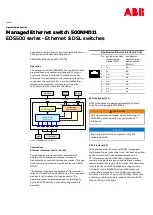
Chapter 4. Web Configuration & Operation
322
CHAPTER 4
WEB OPERATION & CONFIGURATION
Additional code:
Example: 1320300003.
Emergency Call Service
Emergency Call Service:
Emergency Call Service (e.g. E911 and others), such as defined by TIA or NENA.
Policies
Policy ID:
Specify the ID for this policy.
Application Type:
The application types include “Voice”, “Voice Signalling”, “Guest Voice”, “Guest Voice Signalling”,
“Softphone Voice”, “Video Conferencing”, “Streaming”, “Video Signalling”.
Tag:
Tag indicating whether the specified application type is using a “tagged” or an “untagged” VLAN.
VLAN ID:
Specify the VLAN ID for the port.
L2 Priority:
Specify one of eight priority levels (0-7) as defined by 802.1D-2004.
DSCP:
Specify one of 64 code point values (0-63) as defined in IETF RFC 2474.
4.11.3 Neighbours
Local Port:
The local port that a remote LLDP-capable device is attached.
Chassis ID:
An ID indicating the particular chassis in this system.
Port ID:
A remote port ID that LDPDUs were transmitted.
Port Description:
A remote port's description.
System Name:
The system name assigned to the remote system.
System Capabilities:
This shows the neighbour unit’s capabilities. When a capability is enabled, the capability is
followed by (+). If disabled, the capability is followed by (-).
Management Address:
The IPv4 address of the remote device. If no management address is available, the address
should be the MAC address for the CPU or for the port sending this advertisement. If the neighbor device allows
management access, clicking on an entry in this field will re-direct the web browser to the neighbor’s management
interface.
Содержание IFS-1604GSM Series
Страница 385: ......
















































